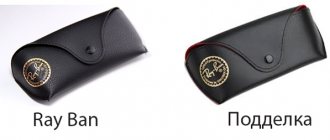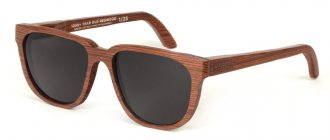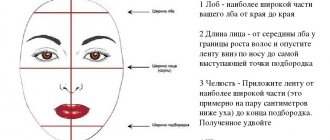Points are selected based on several parameters. In addition to configuration and design, it is important to choose the right size. There are three values needed for this: the width of the lens and bridge, and the length of the temple. They are usually indicated from inside the temple (arm) of the glasses. Find out in the article how to determine the frame size according to this marking.
In this article
- Why is it so important to choose a model by size and how to measure the bridge of your nose for glasses?
- How to measure the necessary parameters?
- What errors can be made when choosing glasses?
- Where to buy glasses?
Why is it important to choose a model by size?
- It's aesthetically pleasing.
If the overall width of the frame is too large, then wearing glasses will make you look like a dragonfly. Models that are too narrow look as if they are too tight. A frame of the right size looks harmonious. If the parameters are chosen incorrectly, then harmony and aesthetics are violated. - It's comfortable.
If the frame size is too large, the glasses will fall off, you will have to adjust them every few minutes, and you will have to completely forget about sports or active recreation. Small - they will put pressure on your temples, and as a result, a headache will become your constant companion. If you choose the wrong bridge size, the frame will put pressure on the bridge of your nose, which is also very unpleasant and can leave marks (red dents) on the skin.
How to find out the required frame size?
Usually, buyers focus on whether the glasses as a whole are too big, forgetting about individual parameters: the width of the lens, bridge, etc. But there are at least three main parameters that you need to pay attention to in order to choose the right size of glasses:
- Lens width/size. This is the distance from the temple to the bridge of the nose.
- Nose bridge width/bridge size. The length of the septum from one lens to another.
- Temple length. The distance from the very beginning of the temple to its tip.
Manufacturers may specify other parameters, such as the height of the lens or the overall width of the frame from temple to temple. This data helps when buying glasses remotely, and also simplifies the work of opticians: knowing the parameters of glasses, they will not offer customers many different models, but will immediately settle on the best options.
The size of the frame is indicated either on the left temple or on the bridge of the nose. Lens size, bridge size and temple length are written in this order, separated by a dot or dash, sometimes separated by other symbols.
If you want to choose the size of glasses, but for some reason your specialist did not give you specific recommendations on the width of the lens, the overall size of the glasses, etc., measure your face, determining the distance between the temples. The imaginary line along which you will take measurements should pass through the eyes. To be more precise in determining the size of glasses, use not only a ruler, but also pencils: attach two pencils to your ears and measure the distance between them. As for other data (for example, interpupillary distance, which is taken into account when making lenses), they are probably in the recipe.
A small recommendation for the future: the parameters indicated on the earhook may be erased over time. To make it easier to choose your glasses size next time, write down and save these numbers. This way you will accurately save information about the height and width of the lens, the distance from temple to temple and other important values of the frame in which you were comfortable.
Glasses sizes
Just because a pair looks nice on display at an optical store doesn't mean it will look good or fit comfortably on your face. The optical device must fit the person, not press or wobble.
Looking closely, you can see 3 numbers imprinted on the inside of the temples. They look like this: 48-19-140.
The first number, the lens size, represents the horizontal width. In this case, the holes in the frame for the lenses are 48 mm wide. The lens size of most eyeglass frames ranges from 40mm to 62mm.
The second number is the size of the bridge - the distance between the right and left glass. In other words, this is the size of the bridge that rests on the bridge of the nose. In this case the width is 19 mm. The frame bridge size ranges from 14–24 mm.
The third number is the temple length - the length measured from the frame hinge to the end of the temple. In the example it leaves 140 mm. Length - 120–150 mm.
In addition to the eye size, bridge size and temple length, there are other numbers (letters and names) printed on the inside of the frame. They usually indicate the model and/or color.
Optics of different shapes, but the same size, fit differently. Therefore, you need to try on and not buy a product without trying it on.
Table. Dimensions of rectangular and round optics
| Size | Rectangular | Round | ||||
| Height | Bridge | Bow | Height | Bridge | Bow | |
| 40 | — | 36,2 | 21 | 120 | ||
| 47 | 38 | 22 | 145 | 44 | 20 | 140 |
| 49 | 42 | 21 | 140 | 46,8 | 21 | 145 |
| 50 | 40 | 22 | 150 | 46,9 | 21 | 145 |
| 51 | 44 | 21 | 145 | — | ||
| 52 | 36 | 18 | 145 | 49 | 21 | 145 |
| 53 | — | 50 | 20 | 140 | ||
| 54 | 47 | 18 | 150 | — | ||
| 55 | 40 | 18 | 145 | 50,4 | 21 | 135 |
| 56 | — | 51,5 | 19 | 140 | ||
Table. Ray Ban sizes
| Model | Aviator | Wayfarer 2140 | Wayfarer New 2132 | Clubmaster 3016 | ||||||
| Size | 55 | 58 | 62 | 47 | 50 | 54 | 52 | 55 | 49 | 51 |
| Height | 47 | 49 | 55 | 38 | 40 | 47 | 36 | 40 | 42 | 44 |
| Face Width | 132 | 138 | 148 | 136 | 140 | 147 | 135 | 142 | 141 | 144 |
| Bridge | 14 | 22 | 22 | 18 | 18 | 18 | 21 | 21 | ||
| Temple length | 135 | 135 | 140 | 145 | 150 | 150 | 145 | 145 | 140 | 145 |
How to choose glasses by size
Buying doesn’t have to be strictly “digital to digital.” Minor fluctuations are acceptable:
- lenses - +/- 5 mm;
- bridge - +/- 1 mm;
- temple — +/- 5 mm.
An optics salon will help you choose the right accessory size. Fitting rules to follow:
- the weight of the frame is evenly distributed;
- the temples of the temples lightly touch the head;
- nothing presses;
- the temples are long enough to extend beyond the ears;
- do not fall when bending forward;
- When you smile, your cheeks don't jump.
When purchasing, keep in mind that the width of the frame should not exceed the width of the face by more than 3 mm; exceptions include cat eye, butterfly and dragonfly shapes.
By paying attention only to the appearance of a sun protection product, they make a fairly common mistake. The result is that the accessory presses or falls off when you turn your head.
size table
The size chart usually contains information about which models are in the collection of a particular brand. In other words, it indicates what range a particular manufacturer has depending on the shape of the glasses.
Such a table greatly facilitates the choice of buyers, because they can immediately refuse to try on some products in favor of others.
The size chart is simply irreplaceable if you are choosing frames online, because in this case it is simply impossible to try on or otherwise determine the size of the glasses, the overall width of the frame and other parameters.
How to choose the right sunglasses without trying them on?
As you know, the prices of an online store please customers, but the only drawback is the lack of opportunity to try on the selected product.
In order to guess the size of the accessory , the buyer just needs to calculate the width of the future glasses according to the instructions described above and determine the appropriate length of the temple. The easiest way to do this is to measure the corresponding part of the old eyepieces. The obtained values are indicated in millimeters.
Important! All measurements may have slight errors. For example, for the width of the lens it is 3 mm, both minus and plus to the ruler indicators.
How to determine the size of sunglasses?
When purchasing corrective products, recommendations on lens width, temple length and other parameters are usually given by an ophthalmologist. But when it comes to choosing the size of sunglasses, it is not customary to turn to ophthalmologists, so patients look only at the aesthetics and price of the model they like. This approach is wrong.
The width of the frame should be selected by a doctor, even if we are talking about simple sunglasses. If you do not have the opportunity to visit a specialist, then before visiting the store, be sure to measure the width of your face using a ruler (we described this method in more detail above), and when purchasing, look at what parameters are indicated on the temple.
Consider not only the shape of the glasses, their price and design. Try to buy the right size to protect your eyes and avoid discomfort.
Where to buy glasses
High-quality glasses are bought in optical stores. You can inspect the optics, try them on and choose the right glasses.
If the size is known, purchase from the following online stores:
- eBay.com - large selection of products, reasonable prices. The site's services are free for customers. Delivery rules are specified by the seller. Each country has its own platform, the purchase is safe. If you received broken or incorrect glasses, you can file a complaint.
- 6PM - online store provides a wide selection of optics. Offers accessories from popular brands. They often have sales and surprise discounts.
- Amazon.ru is an American company that has become famous for its affordable prices. Does not conduct auctions, all products have a fixed price.
- YOOX.com is a multi-brand online store where you can buy glasses with huge discounts on sales. Branded goods are sold with 70% discounts.
Before purchasing glasses from the listed stores, it is recommended to compare their prices on other sites. Sometimes you can find a unique model at private sales.
What errors are acceptable?
The parameters of the glasses selected by the ophthalmologist can be slightly changed, for example, in terms of the width of the lens and the length of the temple, the frame can be 5 mm wider or narrower, the size of the bridge can differ by 1 mm. If you like a certain model, but the sizes of glasses differ from those recommended by a specialist by the acceptable values, feel free to make a purchase. The main role in this case is played by your own feelings; you should be comfortable.
Another tip on how to choose the size of glasses (this does not apply to you if you have your eye on the “cat-eye”, “butterfly” or “dragonfly” shapes of glasses): the frame can extend beyond the boundaries of the face by 2-3 mm, but no more.
How to determine the width of your sunglasses yourself?
To find out your glasses number, you need measurements.
To independently determine the required width, you can go in several available ways:
- Try on glasses in a store, and then, having chosen the ones that suit you, pay attention to the markings on the temple.
- Look at the same markings on glasses that are already in stock and have proven to be easy to wear. Measure the width yourself. To do this, just take two pencils or pens and place them behind your ears, aligned horizontally .
- After this, looking in the mirror for ease of manipulation, use a regular ruler to measure the distance between their ends .
Do frame parameters depend on the shape of the glasses?
At an appointment, an ophthalmologist or an optical consultant in an optical salon usually gives recommendations regarding the optimal dimensions of the frame. These recommendations are universal: using them you can determine the size of sunglasses, prescription glasses, computer glasses, etc., regardless of the model.
But, as mentioned above, wide frames such as “cat’s eyes” and others can go beyond the boundaries of the face. Keep this in mind when choosing your glasses size.
When purchasing glasses, always remember that frame width is an important criterion. When going to the optician, write it down in your notebook, phone, or simply remember the glasses sizes selected by the ophthalmologist. With them, your purchase will be healthier for your eyes.
How to identify an accessory of the wrong size
The correct size of glasses is the key to wearing them comfortably. If the size is determined incorrectly, you will inevitably encounter inconvenience.
- A feeling of tightness in the temporal area is an indicator that the frames are too narrow; the glasses are too small for you.
- Glasses regularly fall or slide to the side at the slightest movement - this means that the frames, on the contrary, are too wide.
- A feeling of tightness in the bridge of the nose indicates that the temples are not long enough or that the model is designed for those with narrow faces.
Glasses of the wrong size can cause migraines and blurred vision.
Frame elements
The frame consists of two main parts, namely the frame, which secures the lenses, and the temples, which ensure the specified position of the glasses. The light openings of the frame, limited by the rim, are connected to each other by the so-called bridge, or bridge, or bridge of the nose - the nose part of the frame. Considering that the maximum weight of the finished glasses falls exactly on the bridge of the user’s nose, it is important that the frame ensures the greatest fit of the glasses in this part, and the weight is distributed evenly. Most metal frames, for better fit on the face, are additionally equipped with movable, adjustable nose pads, usually made of silicone or rubber. Specialists in the production of plastic frames successfully solve the problem of fixing and distributing the weight of finished glasses through the design of the frame itself.
The connection between the frame and the temples is carried out using a hinge joint. Sometimes spring-loaded, or flex, hinges are used in the production of glasses. The use of high-quality hinges has a positive effect on the fixation of glasses on the head and their service life. To avoid possible allergic reactions of the skin to metal and compression of the head in the temple area, metal temples are equipped with tips made of hypoallergenic material, such as silicone.
Frames, depending on their design features, can be divided into the following types:
- Rimless, or full-rimmed, frames are frames in which the light openings are completely limited by the rim. Along with metal and plastic, there are also combined models of rim frames, for the manufacture of which both plastic and metal are used;
- Semi-rimmed frames are frames in which the upper part of the light openings is limited by the rim (much less often – the lower part). In addition to the half-rim, nylon fishing line is most often used to attach the lenses in these frames. Semi-rimless frames can be plastic, metal or combinations;
- Rimless frames are frames that do not have a frame. The lenses are held in place by screw fastenings. In traditional rimless frames, the lenses typically have holes in the nasal and temporal portions into which a screw is inserted from the front of the lens and secured from the inside. There are designs that allow the screw to be inserted from the inside, and special decorative fasteners are used to secure it from the outside. One of the advantages of rimless frames is that they are hardly noticeable on the face. However, it should be borne in mind that the use of negative and positive high-refraction spectacle lenses for assembly into rimless frames often negates this advantage;
Glasses marking: sun protection and shade category
When choosing sunglasses, you need to pay attention not only to the shape of the model, lens color and size, but also to protection from the sun, or more precisely, from ultraviolet radiation.
A quality accessory provides protection against two types of UV radiation - type A rays (maximum length is 400 nm) and type B rays (maximum length is 315 nm).
A-type rays are more harmful to vision and eye health in general: under prolonged exposure to this type of radiation, the retina can be damaged. This will ultimately lead to severe vision impairment. This same type of radiation can provoke the development of skin cancer and accelerate the aging process.
B-type, although less dangerous, can also cause serious health damage. Intense exposure to ultraviolet B radiation can lead to blurred vision, photokeratitis, aging haze, and premature skin aging.
Find your nearest optical store
To protect your vision, wear sunglasses that block ultraviolet radiation. And the markings will help you understand which models will protect your eyes and skin of the eyelids.
There is no uniform standard for designating UV protection. Let's look at the most popular:
- The letters UV indicate that protection is present. However, what is the degree of protection and whether the glasses reflect both types of radiation is impossible to understand from such markings;
- UVA and/or UVB - indicates protection from a specific type of UV rays;
- UV and numbers that indicate the maximum length of blocked rays. For example, if the glasses say UV-350, this means that the maximum length of the beam blocked is 350 nm. Thus, the glasses completely protect against type B rays, but some type A rays still reach the eyes. That is, only glasses marked UV-400 will provide maximum protection;
- UV 100% – assumes that the glasses are equipped with 100% ultraviolet protection.
Unfortunately, labeling does not always reflect the real picture. Unscrupulous manufacturers (especially low-quality fakes) may write about protection, but do not equip glasses with it.
It also happens that the glasses have protection, but it is not indicated in the labeling. Some brands may include information about UV protection on a sticker located on the lenses of the glasses.
Dimming category
The light transmittance of spectacle lenses depends on the darkening category. The darker the dark, the less light the glasses let through. The following categories are used:
- The first category (Cat. 1) – the glasses are slightly darkened. As a rule, these are glasses with lenses of light colors - pink, yellow, blue, etc. These glasses are intended for use in cloudy weather or to create a fashionable look, but they do not help on a sunny day. However, glasses of the first category may have full UV protection;
- The second category (Cat. 2) - glasses are designed for sun protection in city conditions. The lenses are significantly darkened, but good visibility is maintained;
- The third category (Cat. 3) is glasses that are recommended for beach holidays. The degree of darkness in such glasses is quite high, so they may be uncomfortable in city conditions;
- The fourth category (Cat. 4) – glasses with the maximum degree of darkening. These are models designed for skiing or recreation on the open sea. Such glasses transmit no more than 5% of light, so using them in everyday life is not recommended.
Cheat sheet for lens size and number
Branded and sports glasses are most often produced in three sizes:
- 54-55 mm. Glasses with the specified lens size are produced for people with narrow faces. Most often, sophisticated, fragile girls and teenagers fall into this category. For children, a separate line of accessories with a special mark is usually produced.
- 58 mm refers to the standard . The vast majority of owners of sun protection optics wear this particular size. It is logical that the most popular brands produce all product lines in this size, while slow-selling sizes are available only in the most common models.
- 60-62 mm lenses are suitable for those with wide faces, as well as for those who like large glasses.
Selection of frames taking into account your individual characteristics
Choosing frames is not an easy task. In order to solve it, there are several things to consider:
- your face type;
- your preferred style of clothing;
Determination of face type
Determining the type of face, or, in other words, its shape, is not difficult. Secure your hair with a headband or bandage so that it does not bother you, and stand close to the mirror. Outline the contours of the face (from the roots of the hair to the chin) with lipstick or a water-soluble marker and evaluate the result.
Characteristics of types of faces
With all the diversity of faces, five main types are most often distinguished: oval, round, triangular (heart-shaped), rectangular and trapezoidal.
- Oval face. It is characterized by a smooth transition from the forehead to the cheekbones, and then to the chin, the widest point being at the level of the cheekbones. The bottom of an oval face is usually longer than the top.
Recommended:- frames of almost any shape, from classic to avant-garde;
- frames are slightly wider than the size of the face at the widest part, in order to reduce the elongated oval of the face (as a rule, elongated faces are also quite narrow);
- massive frames with a wide, low bridge of the nose, which can distract attention from a long narrow nose, and with low-slung temples, which help neutralize the effect of elongation (especially if the lower and upper rims of the frame are formed by horizontal lines);
Not recommended:
- too large frames that will be dissonant with facial features;
Recommended:
- frames with straight lines forming pronounced angles with the sides;
Not recommended:
- frames too small;
- round frames;
Recommended:
- frames with oval or round light openings, frames with rounded edges;
Not recommended:
- bulky frames that will enhance the triangle effect: the chin will look even narrower and sharper, and the forehead area will look even wider;
- cat eye frames;
- frames with high temples;
Recommended:
- rounded, oval frames that will help smooth out angularity and lighten the heavy lower part;
Not recommended:
- angular frames that emphasize the heaviness of the face;
- frames that are too small and dissonant with facial features;
- frames with low-slung temples;
Recommended:
- cat-eye frames to add width to the top of the face and draw attention away from the chin;
Not recommended:
- any frames that emphasize the heavy lower part of the face;
- frames with low temples;
Preferred clothing style
The preferred style of clothing is largely determined by a person’s lifestyle. With all the variety of styles, we will highlight the three most capacious:
- Business style
The main features of business style, or business style, are rigor, restraint, functionality, and conciseness. In addition to a business suit, an important attribute of modern business style are glasses for vision correction. A good solution for a business person may be politically correct rimless glasses that do not limit the field of vision with frames. Sometimes they are called glasses of politicians due to the latter’s special commitment to them. They are also often chosen by the hosts of political talk shows and other intellectual programs. To create rimless structures today, materials such as stainless steel, titanium and titanium-based alloys are often used.It's much easier to be seen as a democrat with rimless or aviator glasses than with strict rectangular cellulose acetate sunglasses. However, the latter will be quite appropriate when a business person needs to strengthen his authority, which is especially important when he takes his first steps in business. At the same time, however, one cannot ignore his face type.
- Extravagant style
Extravagant style is often preferred by students and people of creative professions (artists, fashion journalists, photographers, designers, bloggers). They love contrasting combinations, bold shapes and colors, unexpected combinations of textures, asymmetrical cuts and bright accessories, including, of course, glasses. Plastic glasses made in retro style, or genuine vintage glasses, can also look very extravagant. When choosing frames, special attention should be paid to color. Fans of extravagant style often gravitate towards bright colors. A good solution may be frames made of two- or three-layer cellulose acetate, which combine several colors at once. The result of overdubbing can be a completely boring mix! - Casual style (everyday)
Casual is a style in which the main emphasis is on convenience and comfort. This style is quite diverse and, among others, includes the following areas:- Sports-casual. Its name speaks eloquently for itself. Fans of this substyle are modern residents of megacities, whose lives are dynamic and fast-paced. The ideal clothes for them are classic jeans, T-shirts, polos, and the ideal shoes are sneakers, but not those designed specifically for sports, but special “urban” models. The ideal glasses for them will be fashionable sports models created specifically for fans of an active lifestyle;
- Smart casual. This substyle is less strict than the traditional business style. It is often also called Friday style, that is, the day when, on the eve of the weekend, office employees can afford to come to work in less strict than usual, but at the same time elegant and comfortable clothes. Fans of smart casual are free to choose a variety of models. For those who want to feel as free in glasses as if they were not on their face at all, we recommend opting for minimalist rimless frames. Unlike rim-mounted ones, they do not limit the field of view. For those who would like to emphasize or create the image of an intellectual, we advise you to pay attention to plastic full-rim frames made in a retro style, for example, dark “horned” glasses with large round light openings. Nowadays, round “horned” glasses still indicate that their owner belongs to people of intellectual work. However, we must not forget that the shape of the frame should match your face type.










